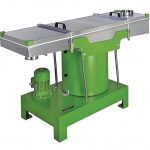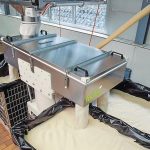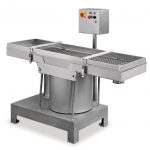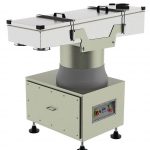As the former manager of a mill in Holland Rudolf Fuchs, founder of the predecessor company of Fuchs Maschinen AG, knew what matters most when it comes to sifting. Based on an impressively simple design, his plansifter has proven to perform very well. During 50 years of use no changes have been made to the basic concept, although various adjustments have been undertaken to details. Moreover, numerous special versions are developed in the meantime, for example with stainless steel bases and motors for applications in the pharmaceutical industry.
Author Daniel Baumann CEO, Fuchs Maschinen
Even though the sifter can be universally used, no compromises whatsoever were necessary when it was developed. The basic concept is as simple as it is convincing and has not had to be changed in more than 50 years, although various adjustments have of course been undertaken to details. The seal between the cover and the sieve case underneath the sieve decks has been improved, the complexity of the sieve case holder reduced and the belt guard modified to cope with new safety requirements, etc. Moreover, numerous special versions have been developed with stainless steel bases, either glass pearl blasted or with a ground finish, and stainless steel motors for diverse applications in the pharmaceutical and food industries.
Working principle
The machine is used in practically all industrial sectors where bulk material has to be processed. It is especially suitable for the three main sifting applications: sizing, de-dusting and control sifting. An eccentric drive makes the sieves swing in the plane, eccentric movement familiar from gold diggers. In contrast to the high frequency vibration techniques commonly employed, the Siftomat offers the benefit of very gentle product processing. Furthermore, the absolutely plane sifting movement has a very positive effect on the sifting quality compared to a large number of mostly uncontrollable vibrating movements.
The product is inducted through an inlet nozzle into the back area of the sieve. The sifting movement, combined with the inclined position of the sieve, conveys the product forward. Sifted material with grain sizes smaller than the mesh falls through the sieve. Any larger components are pushed over the sieve’s full length. The advantage is that grains which are close to the size limit still have enough time to drop through the mesh as long as their size is acceptable. Compared to tumbler sifting machines, in which the product follows a spiral path from the inside to the outside, it is much simpler to find the optimal adjustment. Only the slope needs to be set – on small to medium-sized machines by means of two screws (or eight screws on bigger sifters). The ideal slope is preset at the factory and should normally be left as it is. The speed setting can also be left unchanged for most products. In special cases, or with more demanding products where bulk materials must be sorted according to their length, a frequency converter is required. The following are typical examples of bulk materials which are sorted according to length:
- Longs and twins of plastic granules
- Oversized textile fibres of flocculants
- Waste or undersized pieces of cut vege-tables
Efficient sieve cleaning systems
Products with an irregular shape or near mesh-sized particles have a tendency to clog the sifter. In such cases each sieve deck where clogging occurs can be fitted with a ball sieve cleaning system consisting of a stainless steel frame placed underneath it. This frame has a coarse wire mesh at the bottom and is open at the top. The system contains cleaning balls of natural rubber/polyurethane or silicone. The sieve movement hurls these balls against the sieve from below, knocking out any grains that have stuck to the mesh. This simple and efficient sieve cleaning system is suitable for any sifter, no matter how fine or how coarse.
Fine-meshed sieve fabrics down to 200 µm can be additionally excited using ultrasonic frequencies. The sound waves generated in this way are transmitted to the sieve frame and fabric by means of a converter. The process utilised by Fuchs is innovative and patented. What makes it so unusual is that the frequency varies continuously between 30 and 38 kHz. This has proven especially effective with fine powders and mesh sizes <200 µm since it prevents the sieve from getting clogged and increases the throughput.
As production manager, Rudolf Fuchs paid particular attention to handling. The easier the machine is to handle, the less time-consuming and the more accurate it will be. All parts in the sieve case in contact with the product can be cleaned without difficulty. Both the sieves themselves and all sieve cleaning systems and spacer frames can be changed or replaced in record time to adapt the sifter to different products. With most sieve sizes, this job can be done by a single person without any tools.
Toolless dismantling of the complete sieve case is also possible for cleaning in a special washing room or an autoclave (this is standard with medium-sized sieves and offered as an option for bigger machines).
Small to medium sifting capacities
Thanks to its various advantages, the Siftomat can be used in a wide range of industrial applications, notably in the food and plastics industries as well as in pharmaceuticals and chemicals. It can be fitted with one to three sieve decks, for instance for de-dusting or control sifting with one deck or for both simultaneously with two decks. Bulk material can also be sorted in up to four fractions (with different granulometry). Up to three superposed sieve decks can be fitted in this case.
The Siftomat plansifter can process anything from a few kilos to several tons per hour. A total of eight different mesh sizes are available from mini (350 x 550 mm sifting surface) to 7 (960 x 1840 mm).
The harmonious, quiet and gentle sieve movement not only has a positive effect on the product to be sifted but also on the operating life of the sifter. The machine can run 365 days a year in three shifts. Maintenance is restricted to occasional greasing of the eccentric drive and checking the drive belt. Operators working on the Siftomat machine appreciate its unproblematic handling and amazingly quiet operation.
Hall 5.1, Booth E3
cpp-net.com/0215446
Share:










